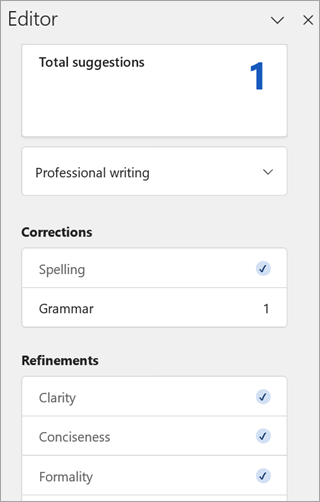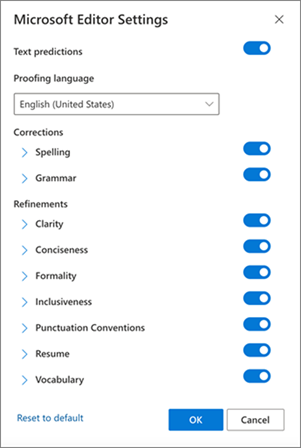Check spelling before sending a message
Applies To
Microsoft Editor is conveniently integrated into many versions of Outlook. Editor provides suggested refinements for clarity, conciseness, inclusive language, and more. Editor suggestions are underlined in red in the message window. You can use the Editor Settings panel to customize your Editor preferences, including the proofreading language.
Note: Editor might not be available in all classic versions of Outlook. In those versions, you can check the spelling in your email message at any time by clicking Review > Spelling & Grammar.
Not sure which version you're using? See What version of Outlook do I have?
Note: If the steps under this New Outlook tab don't work, you may not be using new Outlook for Windows yet. Select Classic Outlook and follow those steps instead.
Use Editor when drafting a message in new Outlook
-
To use Editor, on the Message tab in the Options group, select Editor.
-
The Editor pane categorizes spelling, grammar, and stylistic issues.
-
Click each category to address the issues.
Note: If you change your mind about an issue you ignored, close and reopen the document, and go back to Editor. Editor will find the issue again.
Review suggestions
Microsoft Editor provides suggestions in the Editor window and in the message body. In the message body, suggestions are underlined in red. Left-click the text underlined in red to view and select suggested changes.
In Microsoft Editor, to focus on the issues you care most about, choose a correction or refinement type, like Grammar or Clarity. Then, use the arrows near the top of the pane to step through each of that type of issue.
Choose a suggestion to incorporate it into your document. If you don't like the suggestion, choose Ignore Once. Or, if you never want this type of suggestion, choose Don't check for this issue.
Note: If you change your mind about an issue you ignored, close and reopen the document, and go back to Editor. Editor will find the issue again.

Turn specific Editor suggestion types on or off in new Outlook
-
While in an email draft in new Outlook, in the simplified ribbon, select the (...) overflow menu. In Classic ribbon, select the Editor icon.
-
Using the menu list, select Editor → Editor Settings.
-
The Microsoft Editor Settings panel is displayed. Select the buttons on or off per your preferences. If needed, you can select Reset to default.
-
Select OK to return to your draft.
Manage the Editor suggestions in new Outlook
As you compose your email, Microsoft Editor provides a real-time tally of suggested edits. This number appears below the email composition area. When no suggestions are identified, the Editor icon appears in the same location.
You can disable the display of the Editor suggestions count as follows.
-
In the new Outlook ribbon, select the (...) overflow menu.
-
In the overflow menu list, select Editor.
-
In the adjacent list, select Hide suggestions count.
Change the proofing language in new Outlook
When drafting an email, select the (...) overflow menu, then, select Editor.
-
Proceed to Editor → Editor Settings.
-
Select Manage spellcheck languages.
-
In Proofing languages, select + Add another language.
-
Select the down arrow to scroll through languages, or start typing to select a language, then select Add, then Done.
-
Allow some time for the system to recheck with the newly selected language.
Note: The proofing language selection that is done within email composition will only apply to that specific email draft.
Classic Microsoft 365 Outlook: Use Editor when drafting a message
If you have Outlook for Microsoft 365, you have access to Microsoft Editor.
-
When drafting an email, using the simplified ribbon, select the (...) overflow menu. In Classic ribbon select Editor.
-
Review the suggestions in the Editor pane.
Classic Outlook 2019-2016: Use Spelling & Grammar
To keep the Spelling & Grammar command always within reach, you can add it to the Quick Access Toolbar
If you don’t want to check spelling manually for every message—or you’re worried you might forget!—you can set Outlook to check spelling for you every time.
-
In classic Outlook, click File > Options > Mail.
-
Under Compose messages, check the Always check spelling before sending box.
Now when you click Send, classic Outlook checks spelling automatically. If there are no spelling mistakes, it sends the message right away. If you change your mind and want to edit the message some more, click Cancel to stop the spell check, and then click No.
Use Editor when drafting a message in Outlook on the web or Outlook.com
-
To use Editor, on the Message tab in the Options group, select Editor.
-
The Editor pane categorizes spelling, grammar, and stylistic issues.
-
Click each category to address the issues.
Note: If you change your mind about an issue you ignored, close and reopen the document, and go back to Editor. Editor will find the issue again.
Review suggestions
To focus on the issues you care most about, choose a correction or refinement type, like Grammar or Clarity. Then, use the arrows near the top of the pane to step through each of that type of issue.
Choose a suggestion to incorporate it into your document. If you don't like the suggestion, choose Ignore Once. Or, if you never want this type of suggestion, choose Don't check for this issue.
Note: If you change your mind about an issue you ignored, close and reopen the document, and go back to Editor. Editor will find the issue again.
Turn specific Editor suggestion types on or off in Outlook on the web or Outlook.com
-
While in an email draft, in the simplified ribbon, select the (...) overflow menu. In Classic ribbon, select the Editor icon.
-
Using the menu list, select Editor > Editor Settings.
-
The Microsoft Editor Settings panel is displayed. Select the buttons on or off per your preferences. If needed, you can select Reset to default.
-
Select OK to return to your draft.
Manage the Editor suggestions in Outlook on the web or Outlook.com
As you compose your email, Microsoft Editor provides a real-time tally of suggested edits. This number appears below the email composition area. When no suggestions are identified, the Editor icon appears in the same location.
You can disable the display of the Editor suggestions count as follows.
-
In the Outlook ribbon, select the (...) overflow menu.
-
In the overflow menu list, select Editor.
-
In the adjacent list, select Hide suggestions count.
Change the proofing language in Outlook on the web or Outlook.com
When drafting an email, using the simplified ribbon, select the (...) overflow menu. In Classic ribbon select Editor.
-
Proceed to Editor > Editor Settings.
-
Locate the Proofing language box.
-
Select the down arrow to display the list of available languages.
-
Scroll as needed to locate and select a language.
-
Allow some time for the system to recheck with the newly selected language.
Note: The proofing language selection that is done within email composition will only apply to that specific email draft.
Related articles
Check grammar, spelling, and more in Word
Microsoft Editor checks grammar and more in documents, mail, and the web
















